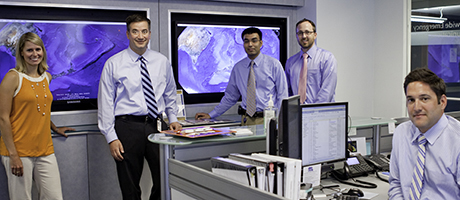By Rachel Muir
Treating sailors who survived a pirate attack isn’t your everyday medical emergency.
But it was one GW’s Maritime Medical Access (MMA) program faced last year when a ship it provided medical care to, the Maersk Alabama, was hijacked by pirates off the coast of Somalia.
The incident made headlines worldwide, and while the ship’s crew wasn’t harmed, it illustrates the range of emergencies that the GW center has to be prepared to treat—all without ever having physical contact with patients.
From its office on the second floor of the Medical Faculty Associates building, MMA provides urgent care via phone and video to approximately 600 ships worldwide. The ships are primarily commercial but also include government and military vessels and private yachts.
GW is the only academic medical center in the country with a maritime medicine program, says Ray Lucas, who serves as the medical director of MMA along with Keith Boniface. Both are GW ER physicians.
About five to 10 calls come in daily to GW’s center—reporting everything from cardiac arrest to cuts, sore throats and broken bones. An EMT is on hand 24/7 to answer calls and connect ships’ officers with physicians whenever needed.
The center’s office is equipped with two oversized flat-screen monitors that track where affiliated ships are around the globe with anchors marking their locations. There are clusters off the Alaskan coast and in the Gulf Coast and a smattering across the Middle East and Asia. Xs mark the medical centers closest to the ships. Telemedicine, for ships equipped with the video hardware, is also available, but most diagnosis is done over the phone.
ER physicians Christopher Lang and Neal Sikka who participate in MMA call the work personally and professionally satisfying.
“The ability to provide unique medical solutions to the mariners at sea is a welcome challenge to my clinical practice of emergency medicine,” says Dr. Lang. “Knowing that these mariners are all by themselves often in remote environments gives me great pride when delivering medical guidance and care.”
The GW physicians have talked ships’ medical officers through countless procedures, including suturing, complex physical exams like evaluating for tendon or nerve injuries, treating skin infections and removal of foreign bodies from eyes.
Sending a ship back to port is not a decision made lightly or often—a vessel can be as far as 30 hours away from land, and a day lost at sea can cost a company tens of thousands of dollars, says Dr. Lang. The vast majority of cases are resolved at sea but a few ships each year have to be diverted to the nearest port of call.
MMA also leads training for ships’ medical officers. The weeklong training, which covers basic paramedic skills, takes place four times a year across the U.S. All ships operating in U.S. waters are required to have medical officers, a role typically filled by ships’ captains.
Kyle Keenan, a nurse, serves as the director of remote medical programs and MMA. He’s constantly in contact with ship’s medical officers, following up on patients’ recovery.
Mr. Keenan says he loves the diversity of the job and aiding people in need. He says the most difficult cases are traumas—incidents in the past year have included a lost limb and a brain injury—which require both advising ships’ medical officers on stabilizing patients and arranging with the Coast Guard or another outfit to airlift them to a hospital as quickly as possible.
“I get to help people throughout the world,” says Mr. Keenan, who worked as an ER nurse before joining MMA last year. “It’s a truly valuable service, and patients are incredibly grateful.”


